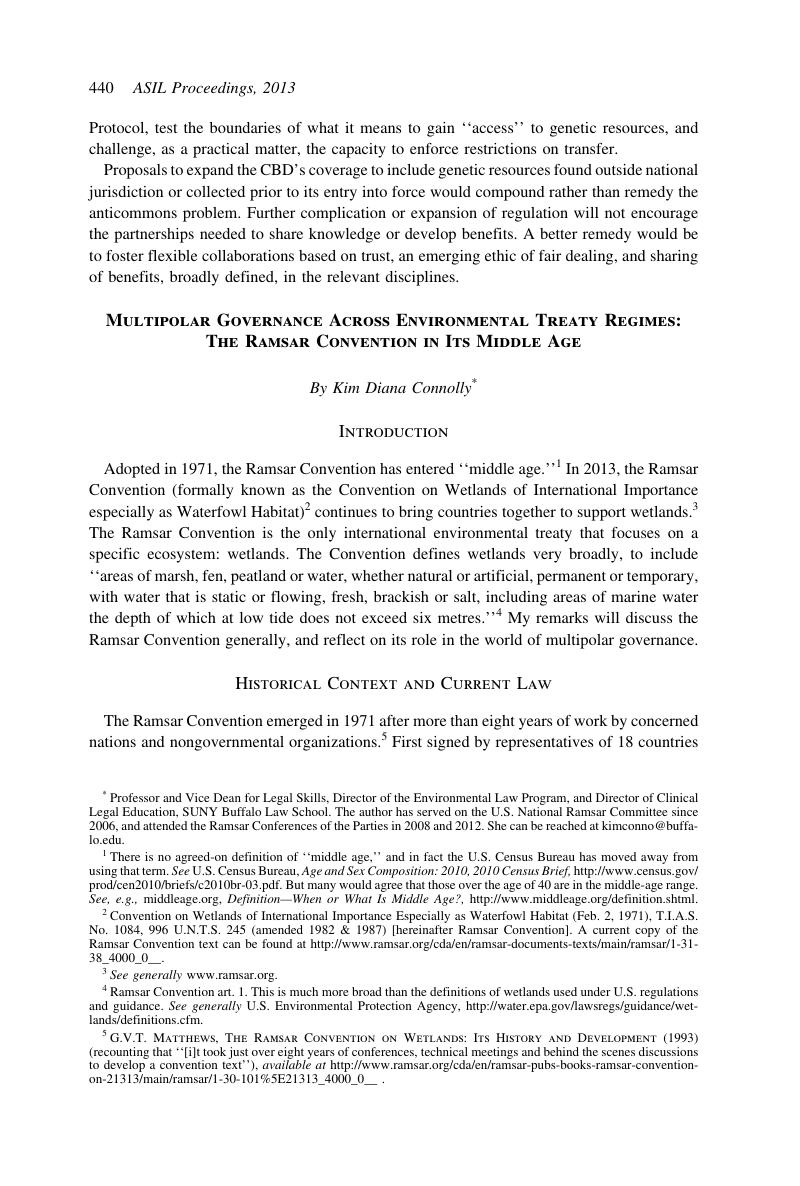No CrossRef data available.
Article contents
Multipolar Governance Across Environmental Treaty Regimes: The Ramsar Convention in its Middle Age
Published online by Cambridge University Press: 20 January 2017
Abstract

- Type
- Multipolar Governance Across Environmental Treaty Regimes
- Information
- Copyright
- Copyright © American Society of International Law 2014
References
1 There is no agreed-on definition of “middle age,” and in fact the U.S. Census Bureau has moved away from using that term. See U.S. Census Bureau, Age and Sex Composition: 2010, 2010 Census Brief, http://www.census.gov/prod/cen2010/briefs/c2010br-03.pdf. But many would agree that those over the age of 40 are in the middle-age range. See, e.g., middleage.org, Definition—When or What Is Middle Age?, http://www.middleage.org/definition.shtml.
2 Convention on Wetlands of International Importance Especially as Waterfowl Habitat (Feb. 2, 1971), T.I.A.S. No. 1084, 996 U.N.T.S. 245 (amended 1982 & 1987) [hereinafter Ramsar Convention]. A current copy of the Ramsar Convention text can be found at http://www.ramsar.org/cda/en/ramsar-documents-texts/main/ramsar/l-31-38_4000_0__.
3 See generally www.ramsar.org.
4 Ramsar Convention art. 1. This is much more broad than the definitions of wetlands used under U.S. regulations and guidance. See generally U.S. Environmental Protection Agency, http://water.epa.gov/lawsregs/guidance/wet-lands/definitions.cfm.
5 G.V.T. Matthews, The Ramsar Convention on Wetlands: Its History and Development (1993) (recounting that “[i]t took just over eight years of conferences, technical meetings and behind the scenes discussions to develop a convention text”), available at http://www.ramsar.org/cda/en/ramsar-pubs-books-ramsar-convention-on-21313/main/ramsar/l-30-101%5E21313_4000_0__.
6 The Convention’s short form is not an acronym, but rather signifies name of the town (Ramsar, Iran) where it was originally signed.
7 The original 1971 version of the Convention can be found at http://www.ramsar.org/cda/en/ramsar-documents-cops-1971-final-act-of-the/main/ramsar/l-31-58-136%5E20803_4000_0__.
8 By its terms, the Ramsar Convention was to enter into force four months after seven parties had ratified it. Ramsar Convention, supra note 2, art. 10. For a current introduction to the history of the Convention, see A Brief History of the Ramsar Convention, http://www.ramsar.org/cda/en/ramsar-about-history/main/ramsar/l-36-62_4000_0__. The United States became a party in 1987 during the Reagan administration. See Contracting Parties in Order of their Accession, http://www.ramsar.org/cda/en/ramsar-about-parties-parties-in-order/main/ramsar/l-36-123%5E20715_4000_0__.
9 Matthews, supra note 5.
10 For a superb overview of the Convention, including its history and modern implementation, see The Ramsar Convention Manual: A Guide to the Convention on Wetlands (Ramsar, Iran, 1971) (6th ed. 2013), available at http://www.ramsar.org/pdf/lib/manua16-2013-e.pdf [hereinafter Ramsar Manual].
11 The actual language of the incorporated amendments can be found at the official documents site: http://www.ramsar.org/cda/en/ramsar-documents-texts/main/ramsar/1-31-38_4000_0__.
12 Guidelines adopted by the Conference of the Contracting Parties to the Ramsar Convention on Wetlands, http://www.ramsar.org/key_guidelines_index.htm. This website provides links to various guidance documents officially adopted during meetings of the Conference of the Contracting Parties.
13 The Ramsar Strategic Plan 2009–2015 as adopted by Resolution X.l (2008) and adjusted for the 2013–2015 triennium by Resolution XI.3 (2012), http://www.ramsar.org/pdf/strat-plan-2009-e-adj.pdf.
14 See generally Basic Information on Secretariats of? Multilateral Environmental Agreements, Mission, Structure, Financing and Governance, http://www.un.org/ga/president/60/summitfollowup/060612d.pdf.
15 See The Ramsar Secretariat, http://www.ramsar.org/cda/en/ramsar-about-bodies-secr/main/ramsar/l-36-71-77_4000_0__.
16 See The Standing Committee, http://www.ramsar.org/cda/en/ramsar-about-bodies-standing/main/ramsar/l-36-71-73_4000_0__.
17 See The Scientific and Technical Review Panel (STRP): Ramsar’s Scientific Subsidiary Body, http://www.ramsar-.org/cda/en/ramsar-about-bodies-strp/main/ramsar/l-36-71-74_4000_0__.
18 See Ramsar Resolution 5.6: The Wise Use of Wetlands, Annex A, http://www.ramsar.org/cda/en/ramsar-documents-resol-resolution-ix-1-annex-a/main/ramsar/1-31-107%5E23536_4000_0__ (suggesting that establishment of national wetland committees can assist with meeting “wise use” obligations).
19 See National Ramsar Committees, http://www.ramsar.org/cda/en/ramsar-activities-nationalramsarcommittees/main/ramsar/l-63-516_4000_0__.
20 See Information Sheet on Ramsar Wetlands (RIS), http://www.ramsar.org/cda/en/ramsar-documents-info-information-sheet-on/main/ramsar/1-31-59%5E21253_4000_0__. A new process for completing and updating future RISs was approved in 2012. Resolution XI.8: Streamlining Procedures for Describing Ramsar Sites at the Time of Designation and Subsequent Updates, http://www.ramsar.org/pdf/copll/res/copll-res08-e.pdf.
21 The current list of sites is maintained by the NGO partner Wetlands International, http://ramsar.wetlands.org/.
22 Ramsar Convention, supra note 2, art. 3.1.
23 Id. art. 2.3.
24 See Ramsar Manual, supra note 10, at 47.
25 Id.; see generally What Is the “Wise Use” of Wetlands?, http://www.ramsar.org/cda/en/ramsar-about-faqs-what-is-wise-use/main/ramsar/l-36-37%5E7724_4000_0__.
26 Related instruments and organizations include the United Nations Environment Programme (UNEP); The Convention on Biological Diversity (CBD); The Convention on Conservation of Migratory Species of Wild Animals (CMS); The UNESCO World Heritage Convention; the United Nations Convention to Combat Desertification (UNCCD); the United Nations Framework Convention on Climate Change (UNFCCC); UNEP’s Convention for the Protection and Development of the Marine Environment of the Wider Caribbean Region and other regional conventions; UNESCO’s Man and the Biosphere Programme; the Global Terrestrial Observing System (GTOS); and others. See Memoranda of Understanding and Cooperation with Other Conventions and International Organiza tions, http://www.ramsar.Org/cda/en/ramsar-documents-mous/main/ramsar/1-31-115_4000_0__.
27 ASIL, http://www.asil.org/am13/.
28 Framework conventions, which leave treaty details for later negotiations, are deemed to be most common in environmental law. Matz-Lück, Nele, Framework Conventions as Regulatory Tools, 1 Goettingen J. Int’l L. 439 (2009)Google Scholar.
29 Gardner, Royal C. & Connolly, Kim Diana, The Ramsar Convention on Wetlands: Assessment of International Designations Within the United States, 37 Envtl. L. Rep. 10089 (2007)Google Scholar; Gardner, Royal C., Connolly, Kim Diana & Bamba, Abou, African Wetlands of International Importance: Assessment of Benefits Associated with Designations Under the Ramsar Convention, 23 Geo. Int’l Envtl. L. Rev. 257 (2008)Google Scholar.
30 Resolution XI.14: Climate Change and Wetlands: Implications for the Ramsar Convention on Wetlands, http://www.ramsar.org/pdf/cop11/res/cop11-res14-e.pdf.
31 The 11th Meeting of the Conference of the Contracting Parties, http://www.ramsar.org/cda/en/ramsar-documents-cops-cop11-cop11-proceedings/main/ramsar/1-31-58-500%5E25863_4000_0__.




